Chernobyl: The end of a three-decade experiment
- Published
Since the explosion at the Chernobyl nuclear power plant in 1986, an area of more than 4,000 square kilometres has been abandoned. That could be about to change, as Victoria Gill discovered during a week-long trip to the exclusion zone.
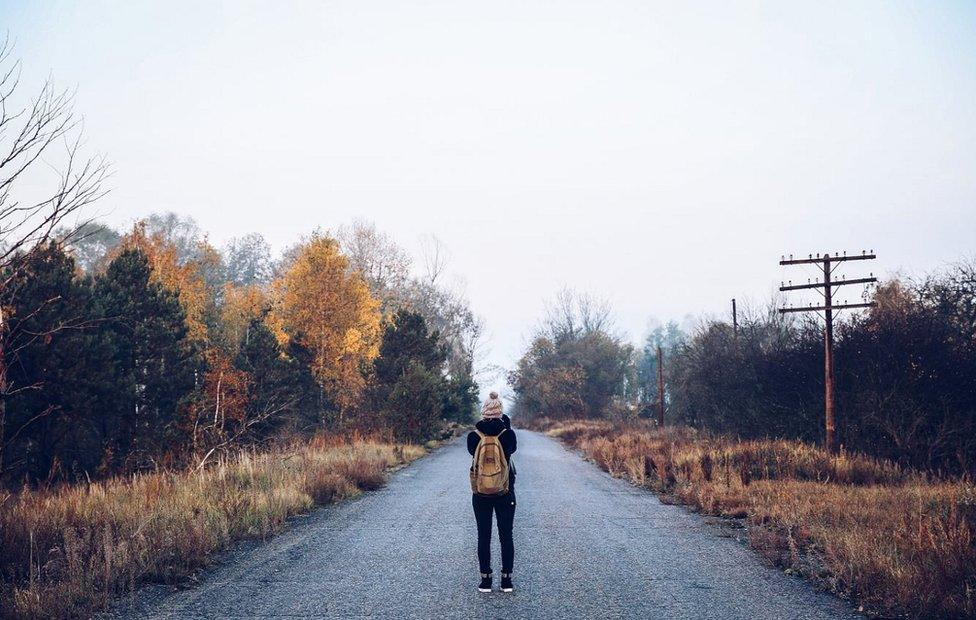
"This place is more than half of my life," says Gennady Laptev. The broad-shouldered Ukrainian scientist is smiling wistfully as we stand on the now dry ground of what was Chernobyl nuclear power plant's cooling pond.
"I was only 25 when I started my work here as a liquidator. Now, I'm almost 60."
There were thousands of liquidators - workers who came here as part of the mammoth, dangerous clean-up operation following the 1986 explosion. The worst nuclear accident in history.
Gennady shows me a coffee table-sized platform, installed here to collect dust. This reservoir's bed dried out when the pumps taking water from the nearby river were finally switched off in 2014; 14 years after the remaining three reactors there were shut down.
Analysing dust for radioactive contamination is just a small part of the decades-long study of this vast, abandoned area. The accident turned this landscape into a giant, contaminated laboratory, where hundreds of scientists have worked to find out how an environment recovers from nuclear catastrophe.
The experiment that turned into a global catastrophe
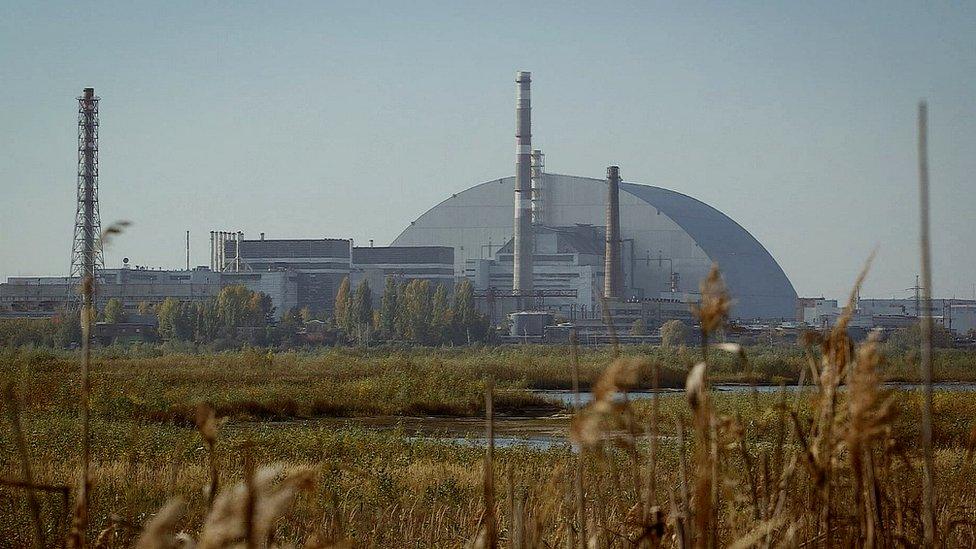
The damaged reactor is now entombed by a steel "confinement structure" as cranes dismantle radioactive remnants within
On 26 April, 1986, at 1:23AM, engineers cut power to some systems at Chernobyl nuclear power plant's number 4 reactor. It was a critical point in a test to understand what would happen during a blackout. What engineers did not know was that the reactor was already unstable.
The cut-off slowed turbines that drove cooling water to the reactor. As less water turned to more steam, the pressure inside built. By the time operators realised what was happening and tried to shut down the reactor, it was too late.
A steam explosion blew the lid off the reactor, exposing the core to the atmosphere. Two people in the plant were killed and, as air fuelled a fire that burned for 10 days, a cloud of radioactive smoke and dust was carried on the wind around Europe.

Chernobyl's post-human landscape
BBC News Our World: In the Shadow of Chernobyl - Watch Victoria Gill's full report from the exclusion zone on Saturday and Sunday, 16 and 17 February, at 2130 GMT on the BBC News Channel, and afterwards on BBC iPlayer.

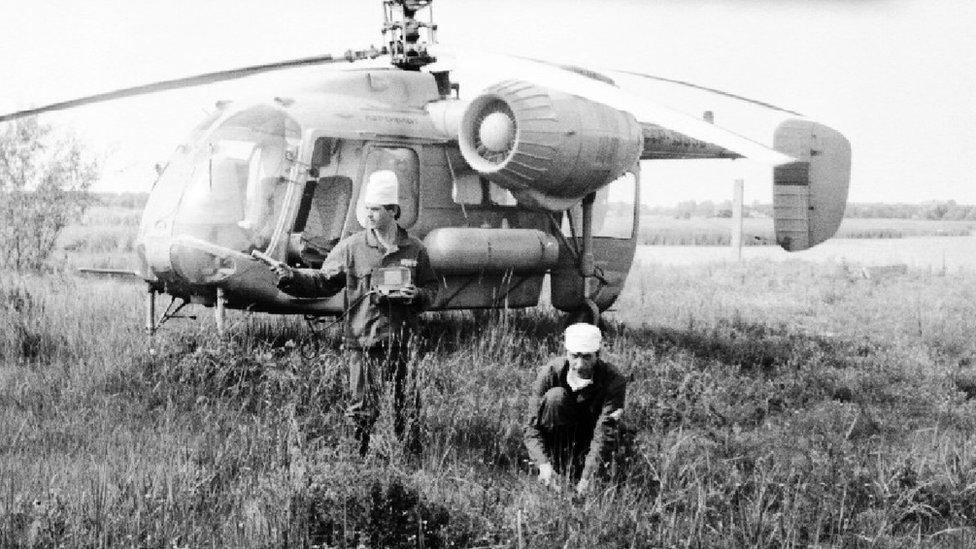
In 1986, Gennady Laptev (on the right) flew by helicopter daily to collect soil and water samples from around the damaged reactor
The first emergency workers rushed in as lethal smoke billowed out. Of 134 who were diagnosed with acute radiation sickness, 28 died within months. At least 19 have died since.
Gennady, an environmental scientist with the Ukrainian HydroMeteorological Institute, started work in the zone just three months after the evacuation. "We used to fly in by helicopter every day from Kiev," he explains, "to collect water and soil samples.
"The important thing then was to understand the extent of the contamination - to draw the first maps of the exclusion zone."
Today, that zone spans Ukraine and Belarus. Covering more than 4,000 sq km - more than twice the size of London. Every community within a 30km radius of the plant was evacuated and abandoned; no-one was allowed to return here to live.
In a forgotten, outer portion of the exclusion zone, people were quietly allowed to return home a few months after the disaster.
Unlike the "30km zone", no checkpoints prevent entry to this semi-abandoned area. Narodichi, a town of more than 2,500 people, is within that more-distant zone. Strict rules govern this officially contaminated district; exclusion zone land must not be cultivated to produce food and it cannot be developed.
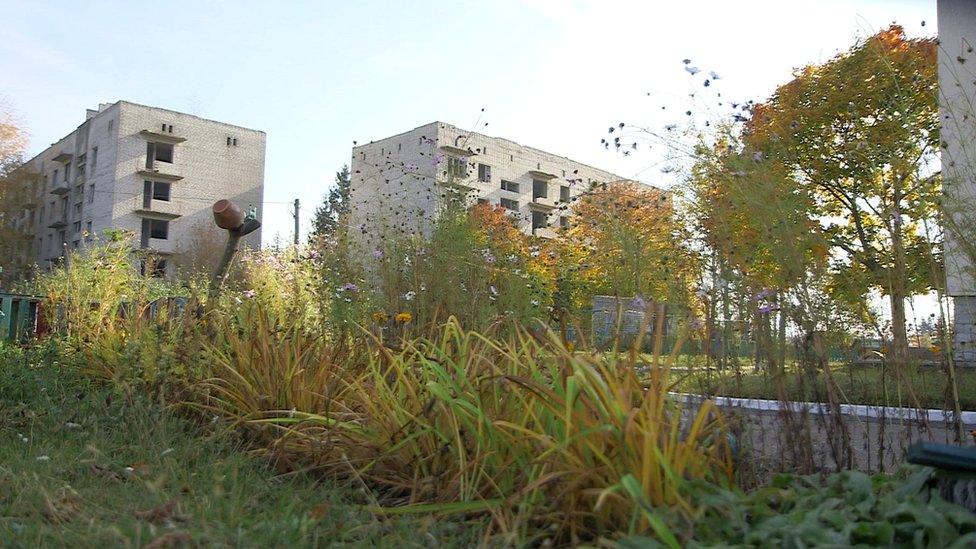
Narodichi is an officially contaminated town within the outer portion of the exclusion zone
Today, though, this part of Ukraine is not easily delineated into two categories - contaminated or clean. Research has shown that Chernobyl's aftermath is more complicated, and the landscape here much stranger - and more interesting - than the stringent "do not touch" rules in Narodichi would imply.
Fear of radiation could actually be hurting the people of Narodichi far more than the radiation itself.
'We're getting less radiation here than on the plane'
Over Gennady's shoulder, I can see the nuclear power plant - less than a kilometre away from the reservoir bed we're standing on. Gleaming in the sunshine is the huge protective steel "New Safe Confinement" that now entombs unit 4. It was slid over the top of the accident's epicentre in 2016. Beneath it, robotic cranes are dismantling 33-year-old, radioactive wreckage.
Prof Jim Smith from the UK's University of Portsmouth, a colleague of Gennady's, is a scientist who has studied the aftermath of the disaster since 1990. Here on one of his numerous research trips to the zone, he shows me a dosimeter - a black plastic phone-sized gadget he carries throughout the visit.
It measures the external dose of radiation he is getting from the environment. Atoms of the nuclear fuel dust that were scattered here by the 1986 explosion are spontaneously breaking down. They are giving out high-energy rays as they do so, and Jim's dosimeter is detecting the dose of those that we are receiving every hour.
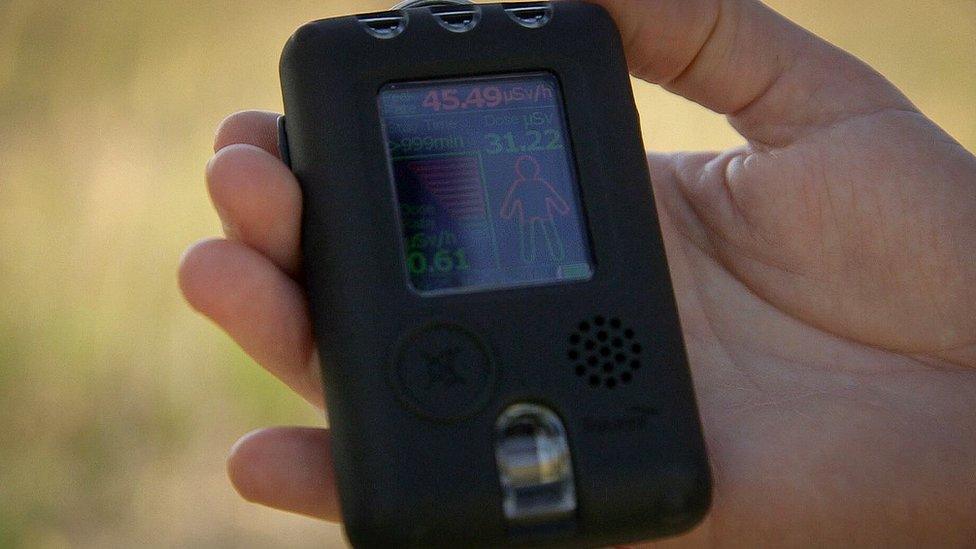
The dosimeter calculates the radiation dose we receive every hour
The readings are in units (called microsieverts) that only make sense to me in the context of other relatively "radioactive activities". At one point in the middle of the flight to Kiev - for example - his dosimeter read 1.8 microsieverts per hour.
"It's currently 0.6," Jim says. "So that's about [a third] of what we were getting on the flight." With the infamous power plant visible in the background, I'm incredulous. But, Jim explains, we live on a radioactive planet - natural radioactivity is all around us. "It comes from the Sun's rays, from the food we eat, from the Earth," he says. That is why, up at 12,000m on an airliner, with less shielding from Earth's atmosphere, we receive a higher dose.
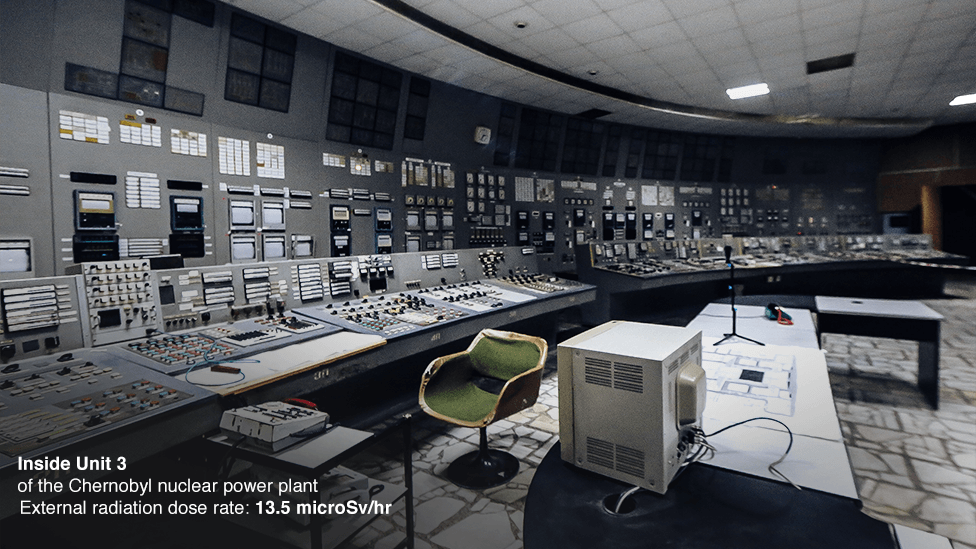
"Yes, the exclusion zone is contaminated," he tells me, "but if we would put it on a map of radiation dose worldwide - only the small 'hotspots' would stand out.
"Natural radioactivity is all around us - it varies from country to country, from place to place. Most of the area of the exclusion zone gives rise to lower radiation dose rates than many areas of natural radioactivity worldwide."
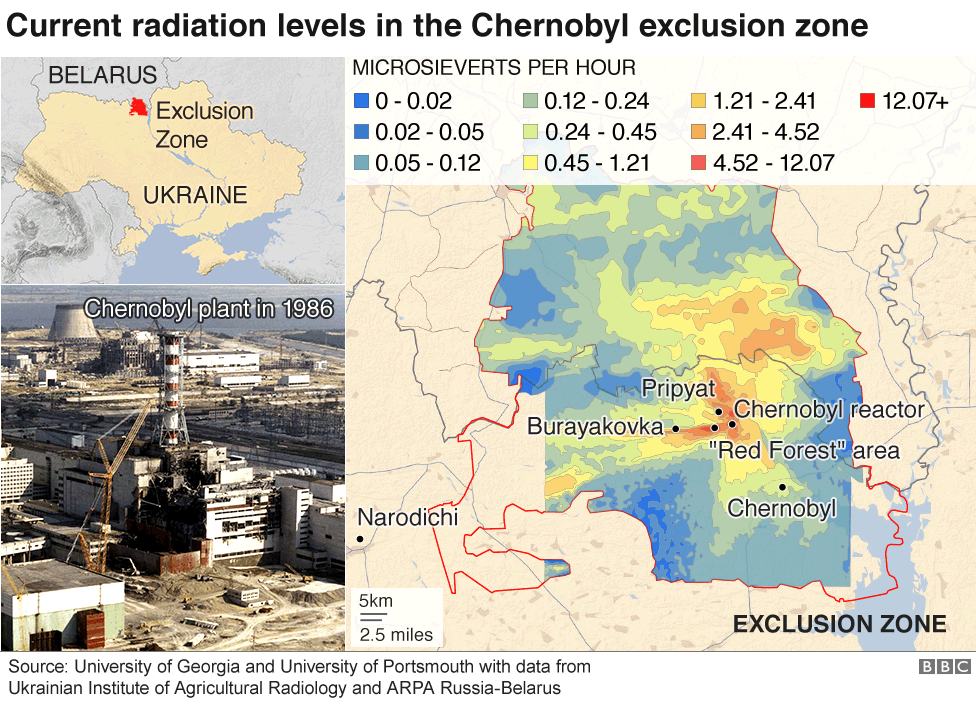
'You don't want to be in the hotspots for long'
While the boundary of the exclusion zone has not changed, the landscape has - almost beyond recognition. Where people were forced out, nature has moved in. Wilderness combined with abandoned buildings, farms and villages gives a sense of the post-apocalyptic.
Jim and his colleagues spend their days here collecting samples and planting cameras and audio recorders, which silently gather information about what wildlife inhabits this post-human place, and how the radiation affects it.
On the second day of our trip to the zone, I follow the team into the Red Forest. This is an exclusion zone hotspot that, because of the direction of the winds in 1986, took the brunt of the shower of radioactive material.
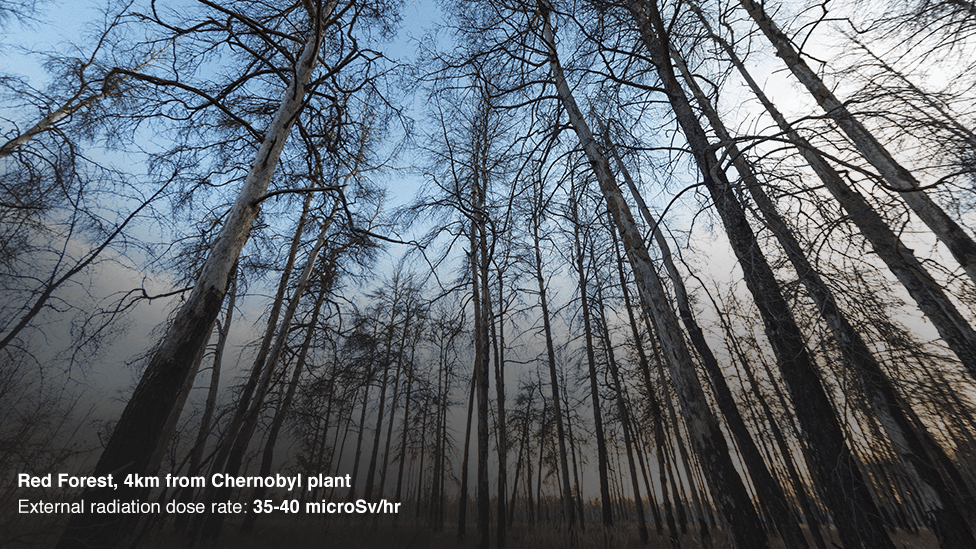
We put on dust suits to avoid contaminating our clothing.
In the forest, Jim's dosimeter reads 35 - almost 60 times the external dose we were getting in the cooling pond.
"We don't want to be here for too long," says Jim. He and the team gather their soil samples swiftly, take some photographs and head back to the car.
'The horses are adapting to the zone'
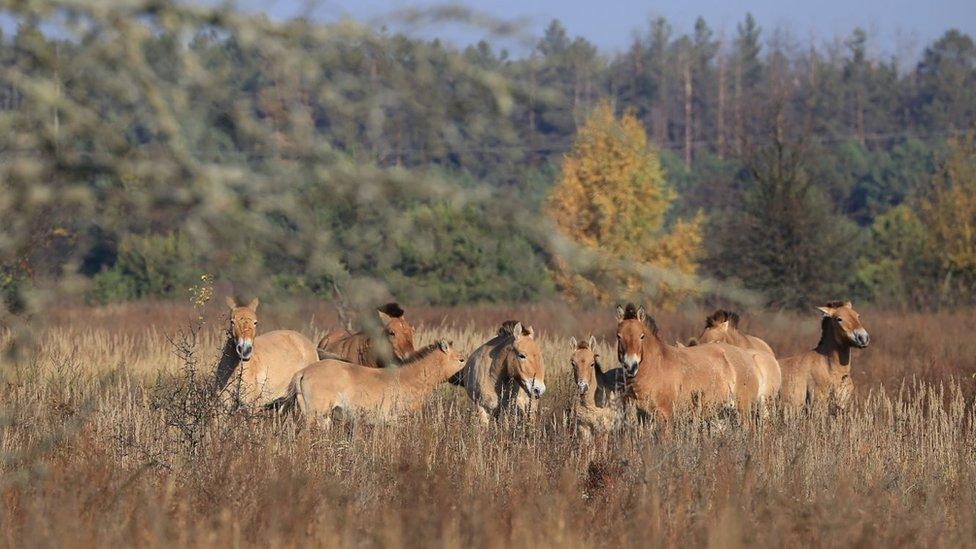
Wild horses were released into the zone as part of an experiment to reduce the risk of wildfires
In the abandoned village of Burayakovka - just over 10km from the power plant - it is a very different approach. Jim and the team take their time exploring the area. The dosimeter reads 1.0 - still less than on the flight.
Inside one small, crumbling but still colourful wooden house, the sad truth of what people so suddenly lost here is apparent. A coat still slung over the arm of a chair is now covered in three decades of dust.
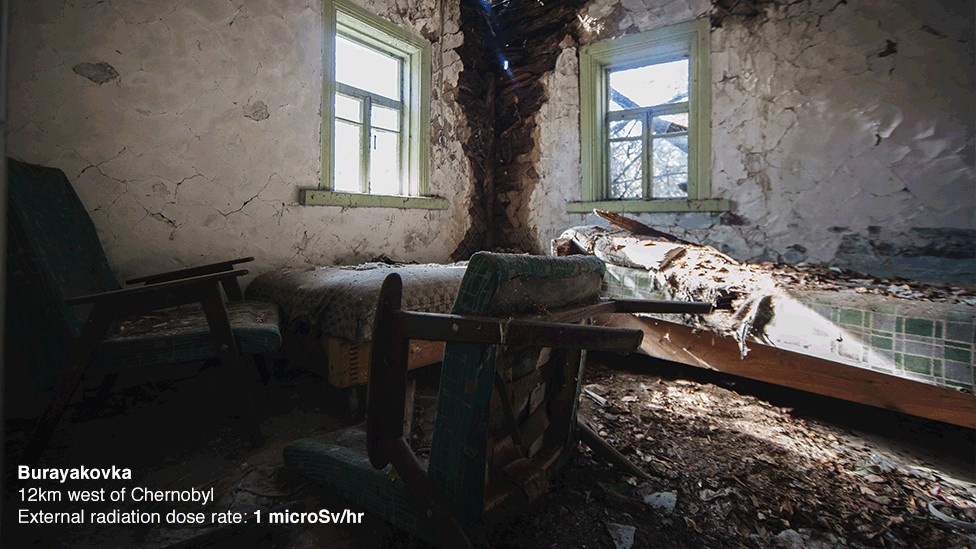
But what people left behind - through farming and gardening - has turned into a strangely rich habitat and provisions for wild animals. Long-term studies have shown that there is more wildlife in the abandoned villages than anywhere else in the zone. Brown bears, lynx and wild boar are seen roaming here.
Dr Maryna Shkvyria, a researcher based at Kiev Zoo, has spent years tracking and studying the larger mammals that moved in when people moved out.
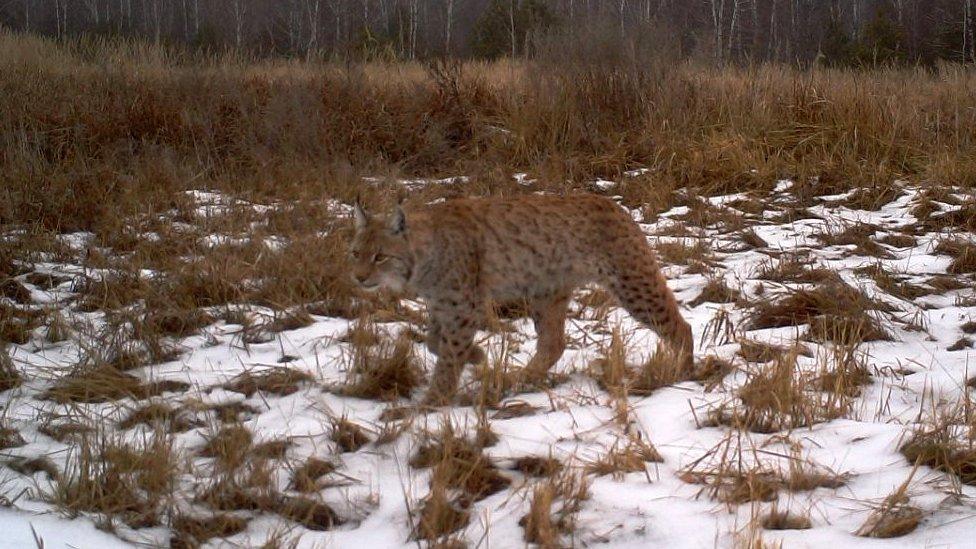
Camera trap images reveal that lynx now roam the exclusion zone
There are studies suggesting that birds in the most contaminated areas show signs of damage to their DNA, but Maryna's work is adding to a catalogue of research that suggests wildlife is thriving throughout much of the exclusion zone.
Chernobyl's wolves, she says, are a particularly striking example.
"After 15 years of studying them, we have a lot of information about their behaviour," Maryna explains. "And the Chernobyl wolf is one of the most natural wolves in Ukraine."
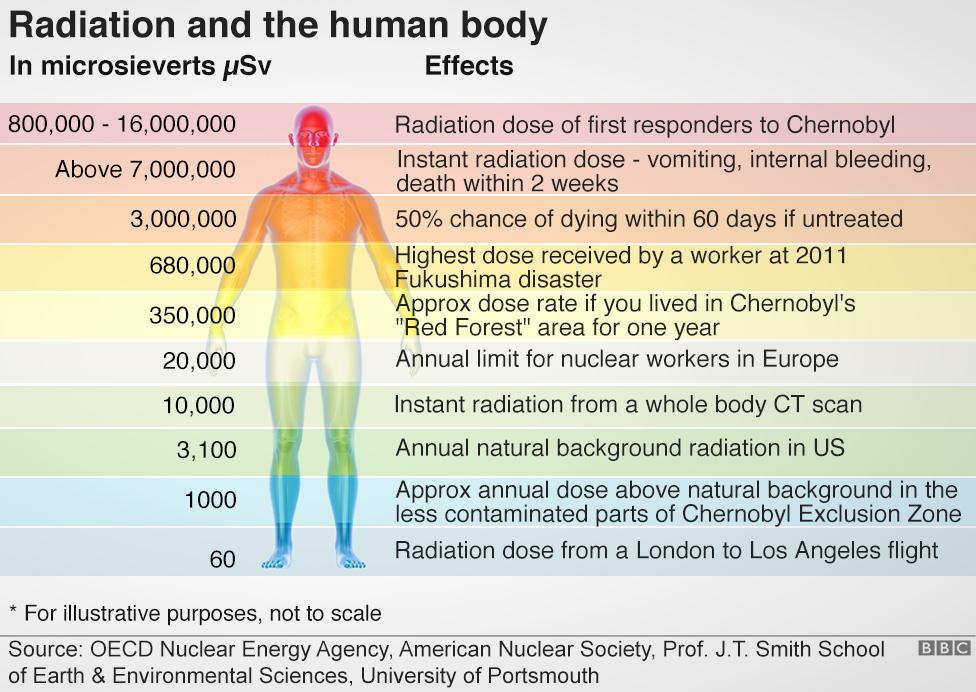
By "natural", she means there is very little "human food" in the wolves' diet. "Usually, wolves are around settlements," Maryna explains. "They can eat livestock, crops and waste food - even pets." But not here where wolves hunt wild prey.
Chernobyl's wolves feed on deer and even catch fish. Some images - caught by camera traps - reveal gentler dietary habits. Wolves have been snapped eating fruit from around trees that used to be in people's orchards.
There is one group of animals that has made the zone its home and that - strictly speaking- should not really be here.
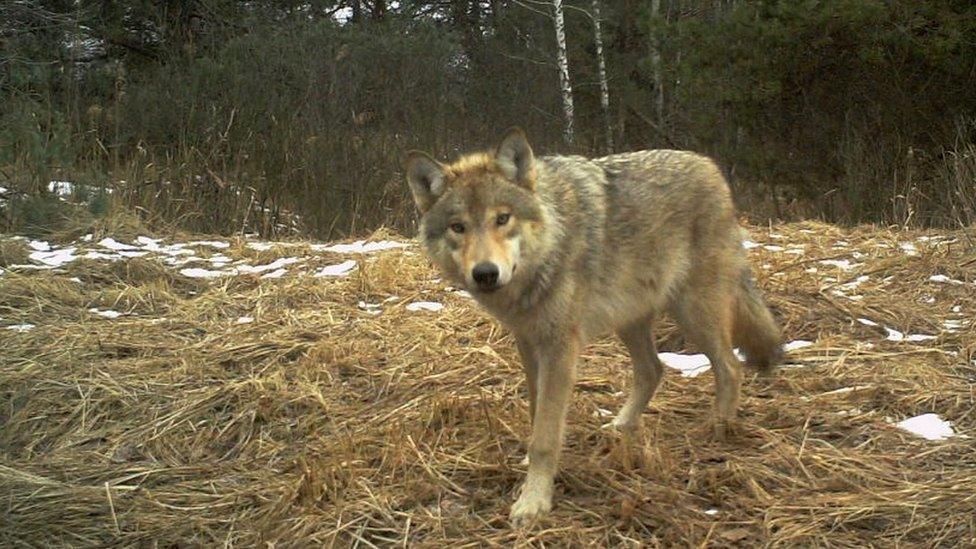
Lack of hunting may have contributed to the success of Chernobyl's wolves
In 1998, Ukrainian zoologists released a herd of 30 endangered Przewalski's horses in the zone. The apparent aim was for the horses to graze overgrowth and reduce the risk of wildfire. There are now about 60 of them - in herds dispersed across Ukraine and Belarus.
They are native to the open plains of Mongolia, so forests peppered with abandoned buildings should not be ideal habitat. "But they're really using the forests," explains Maryna. "We even put camera traps in old barns and buildings and they're using them to [shelter] from mosquitoes and heat.
"They even lay down and sleep inside - they're adapting to the zone."
'You can have the cherry vodka; I made it'
Wildlife might be making the most of what's gradually become a post-human nature reserve, but not every village was left for animals to claim. Some people still live here - deep in the 30km zone.
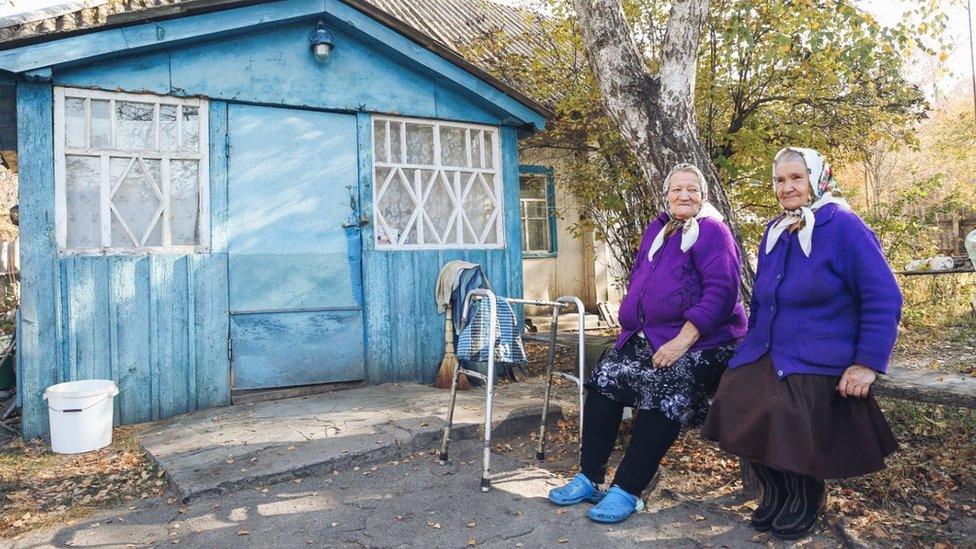
Maria (right) and her neighbour are part of a community of just 15 self-settlers in the zone who grow their own food and make their own vodka
On my fourth day here, we visit Maria's house. She is outside in her garden when we arrive at the gate, and - as I try to introduce myself in a few stumbling words of Ukrainian - she interrupts me by wrapping me in a warm hug and kissing me on the cheek.
Today is her 78th birthday. She is expecting us and has prepared a celebratory breakfast.
Maria ushers me, Jim, his colleague Mike, and our interpreter Denis to a wooden table under a fruit tree.
It is a gloriously sunny day and pleasantly warm even at 9am. Maria starts to bring food - fatty salted bacon, a whole fish, sliced sausage and steaming hot, home-grown potatoes. There are two bottles of what appear to be spirits - one colourless, one dark red.
"If you don't like this vodka, you can have the cherry one - I made it," she says.
Maria and her neighbours make up a tiny community of just 15. Each of these self-settlers, as they are known, travelled back across a patchily enforced exclusion zone boundary and reclaimed their homes in 1986.
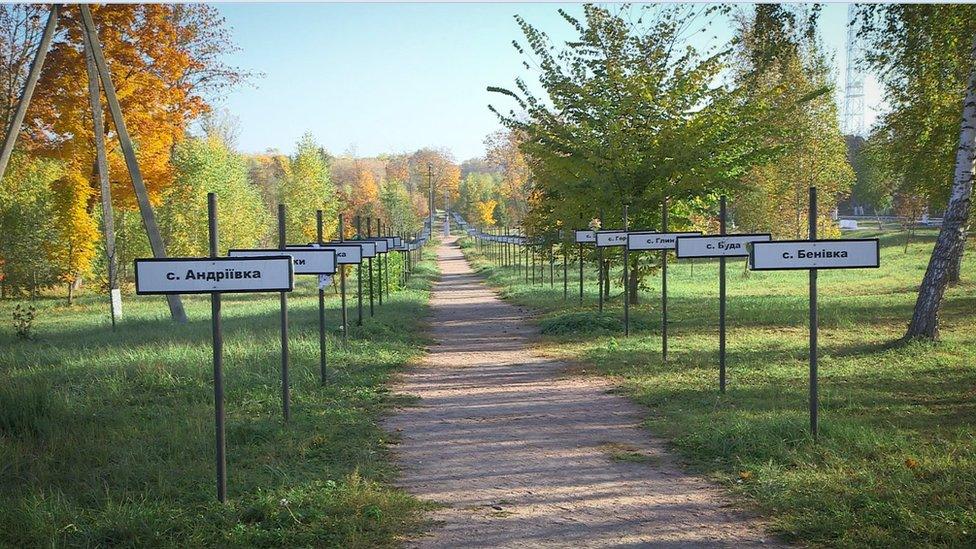
Signs bearing the names of abandoned communities make up a memorial in the town of Chernobyl
Almost every family forced to leave here was given an apartment in a nearby town or city. For Maria and her mother, though, this cottage, with the garden wrapped around it, was home. They refused to abandon it.
"We weren't allowed to come back, but I followed my mum," Maria recalls. "She was 88 back then. She kept saying: 'I will go, I will go'. I just followed her."
There are about 200 self-settlers in total living in the zone and, for an ageing population cut off from the rest of the country, Maria says life is not easy.
"We're all very old," she tells me. "And we take each day as it comes.
"I feel full of life when my children come to visit me from Kiev. Otherwise, it's not so interesting to live here. But you know this is our land - our motherland. It's irreplaceable."
Maria's mobile phone rings and I am struck by the incongruity of our diminutive babushka hostess, standing in her exclusion zone garden, apparently trying to wrap up swiftly a call from her daughter. She is busy with her visitors from the BBC!
Remote as it is, this is a close community. As we sit in the garden (knocking back cherry vodka at our Maria's repeated insistence) her neighbour arrives with a birthday gift. She sits on the bench near the garden gate; she can't walk too far.
The self-settlers are a tiny minority, though. Most people who so suddenly lost their homes here have no hope of coming back.
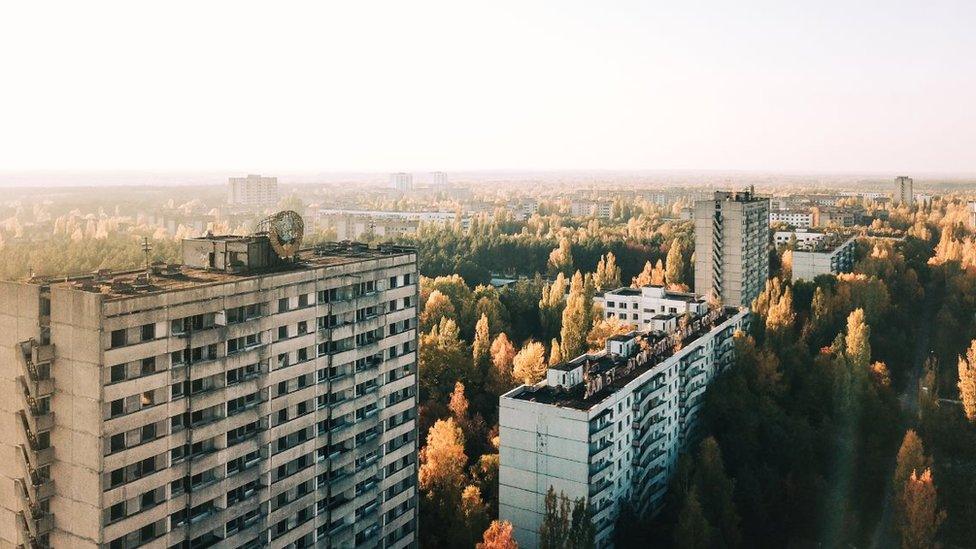
Pripyat was home to 50,000 people before the accident
Most of them lived in Pripyat - a true Soviet dream town, purpose-built for the power plant workers. Just a few kilometres from the plant itself, this town of 50,000 people was emptied overnight. No-one was allowed to return; it is now the archetype of a 20th Century ghost city.
Pripyat was, however, recently deemed safe to visit for short periods and has now become one of Ukraine's most talked about tourist attractions. An estimated 60,000 people visited the exclusion zone last year, keen to witness the dramatic decay.
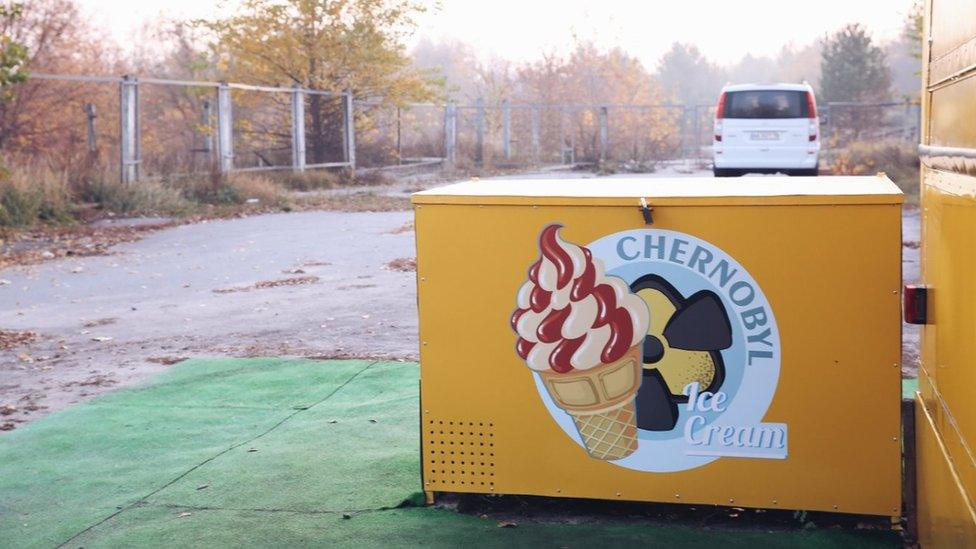
Signs of tourism are popping up around the exclusion zone
Its bleak notoriety has made it the subject of some dark, social media-based showing-off. Search #chernobyl on Instagram and you will find - among the interesting landscapes and tourist snaps - images of anonymous, costumed characters, sometimes wearing gas masks or holding up creepy-looking dolls for the camera.
'Tell people Chernobyl is not such a horrible place'
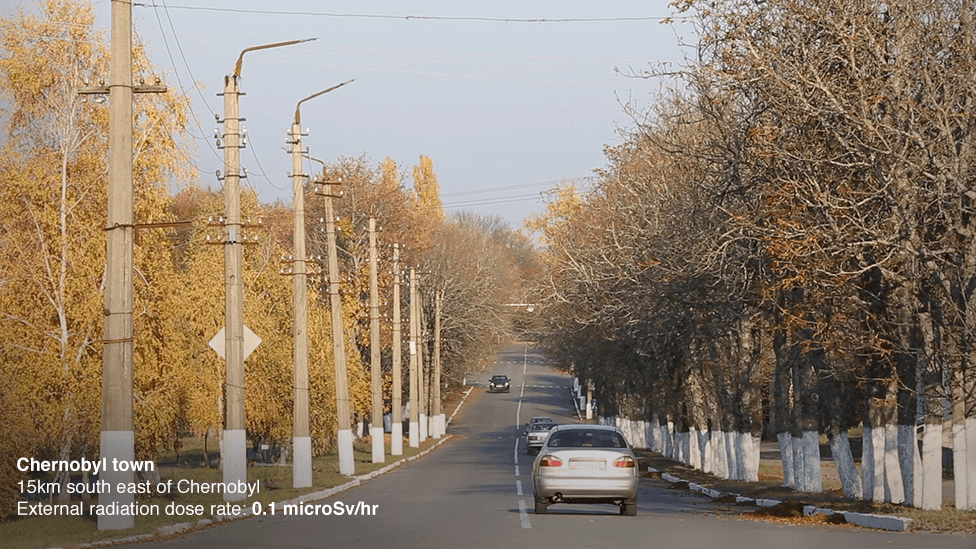
The town of Chernobyl itself - somewhat confusingly much further from the power plant than Pripyat - is in a less contaminated area. It has become a relatively populous hub. Power plant decommissioning staff, scientists and tourists stay here.
Gennady, Jim, me and the rest of the research team are staying in one of its small hotels - a Soviet-style building with an incongruously pretty, well-tended garden around it. This greenery is looked after by Irina, who manages the hotel. She stays here for three months at a time before a colleague takes over. People are only permitted to live in the town for limited periods.
Over a cup of tea on our second evening at the hotel, Gennady translates as Irina tells us about her memories of the accident. She lived in Pripyat at the time with her grandmother.
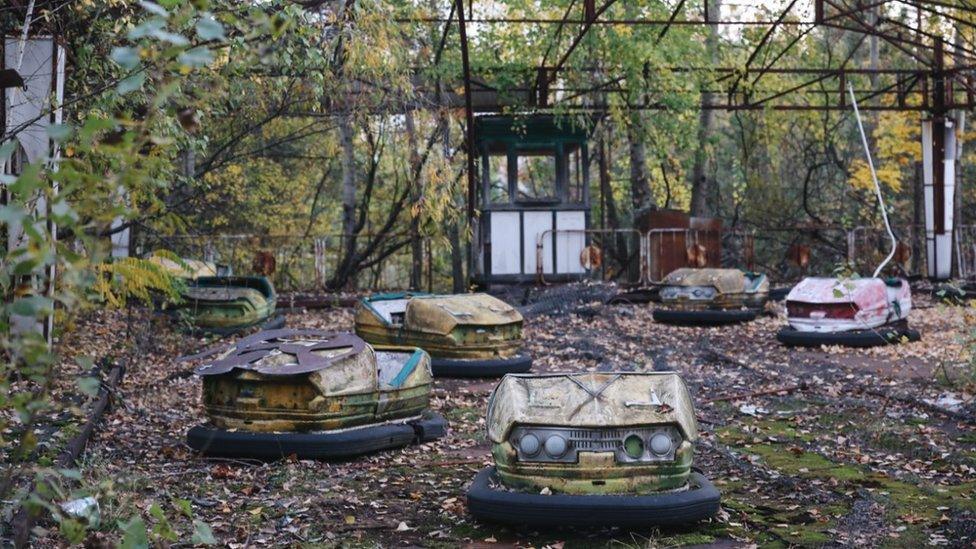
Pripyat's abandoned fairground has become an icon
On 27 April - a day after the explosion - the town was evacuated. People were ordered to leave immediately. They lined up for buses that would take them away from the town and the plant. Irina was on her way back to her grandmother's apartment at the time.
"A friend of my grandmother's was driving a cattle wagon - taking his livestock out," she recalled. "My grandmother asked if he would take me with him, so I climbed on to the cattle wagon.
"I didn't know what was happening."
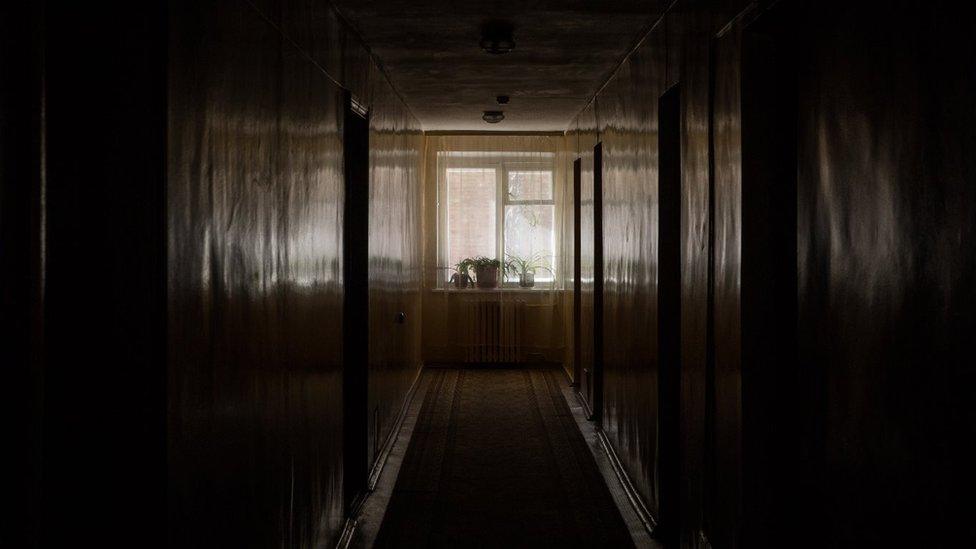
Inside our Chernobyl hotel
But Irina, not unlike Maria, felt a need to return to the zone. She has never been back to Pripyat, though; it would upset her too much to see it now. But she takes pride in tending the flowers around her Chernobyl hotel.
"I like to make it as pretty as possible for the visitors," she tells me. "So maybe you can tell people back home that Chernobyl is not such a horrible place."
'We have forgotten that we are Chernobyl people'
Gennady's 33 years working in the exclusion zone might have been leading up to one meeting at the end of this week. It is being held in a school in Narodichi, the town in the outer zone.
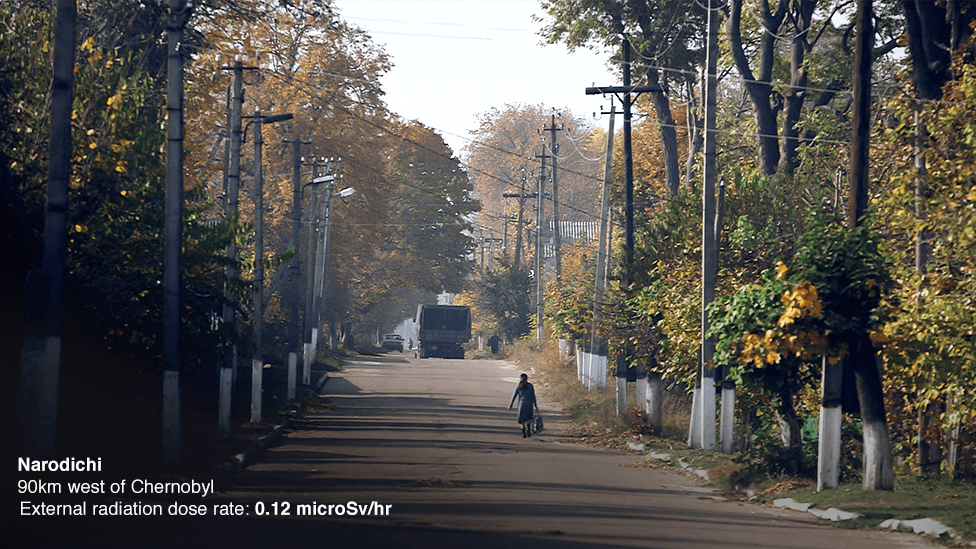
Here, scientists, community members, medical experts and officials from the state agency that manages the exclusion zone are gathering to discuss a change that could transform this district's future.
For the first time since the boundary was drawn, the zone is set to change. Three decades of research have concluded that much of it is safe - for food to be grown and for the land to be developed. Narodichi is one of its least contaminated places.
Jim and Gennady are presenting their conclusions at the meeting. Before it is under way, I have arranged to visit the town's kindergarten, where the children are playing outside in the sunshine.
A rainbow-painted picket fence at the edge of their playground contrasts almost ludicrously with grey, half-built tower blocks next door.
There were 360 children here before the accident. Tatiana Kravchenko, a woman with a perpetual kind smile and who is wearing a thick, bright pink coat, is the kindergarten manager. She remembers the evacuation.
"The children were evacuated together with teachers to 'clean zones'," she recalls. "In three months we were sent back, and we had only 25 children. Eventually, people have come back, new children have been born and gradually the kindergarten started filling up again. Now we have 130 children here."
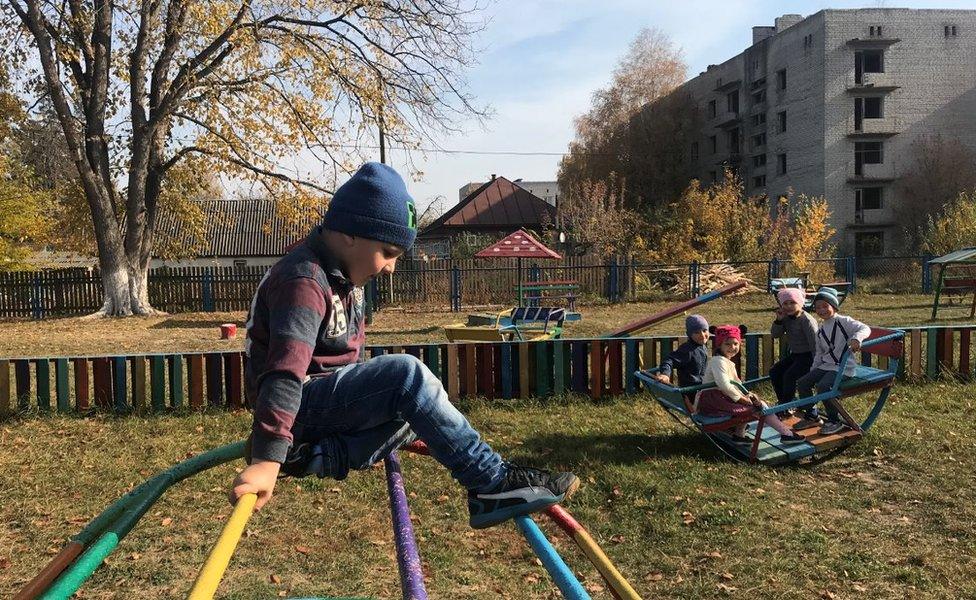
Most of the time, Tatiana says, she does not think of her community as being within the exclusion zone. "We forget that we are Chernobyl people; we have other issues to deal with," she tells me. "It's no secret that half of the parents [of these kids] are unemployed, because there is nowhere to work. I wish that we could build something here - that our community could start to bloom."
'Maybe it's time to redraw the map'
Back in the meeting, Gennady peers over red-rimmed glasses, attentively listening to what is being said. Discussions are taking longer than expected. Much of the community input seems to reflect Tatiana's thoughts - that it is time for restrictions to be lifted here.
But there is a lot at stake.
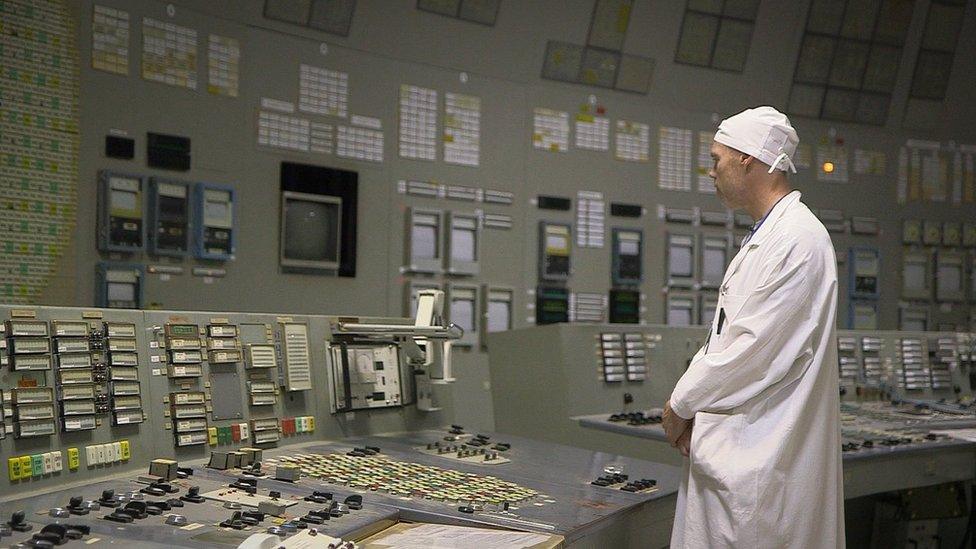
People still fear the legacy of what happened here in 1986
People affected by the accident receive financial compensation from the government. Here, in a town of high unemployment, in a country where the average wage is less than 400USD per month, that income is important.
And many still fear Chernobyl radiation - and the effect that it might still have on their health, and the health of their children. After many years of research, understanding and explaining the long-term health legacy of the accident has been infuriatingly complicated.
It is conclusive that around 5,000 cases of thyroid cancer - most of which were treated and cured - were caused by the contamination. Authorities failed to prevent contaminated milk from being sold in the region; many who were children at the time drank it receiving large doses of radioactive iodine. That was one of the contaminants blasted out of the reactor.
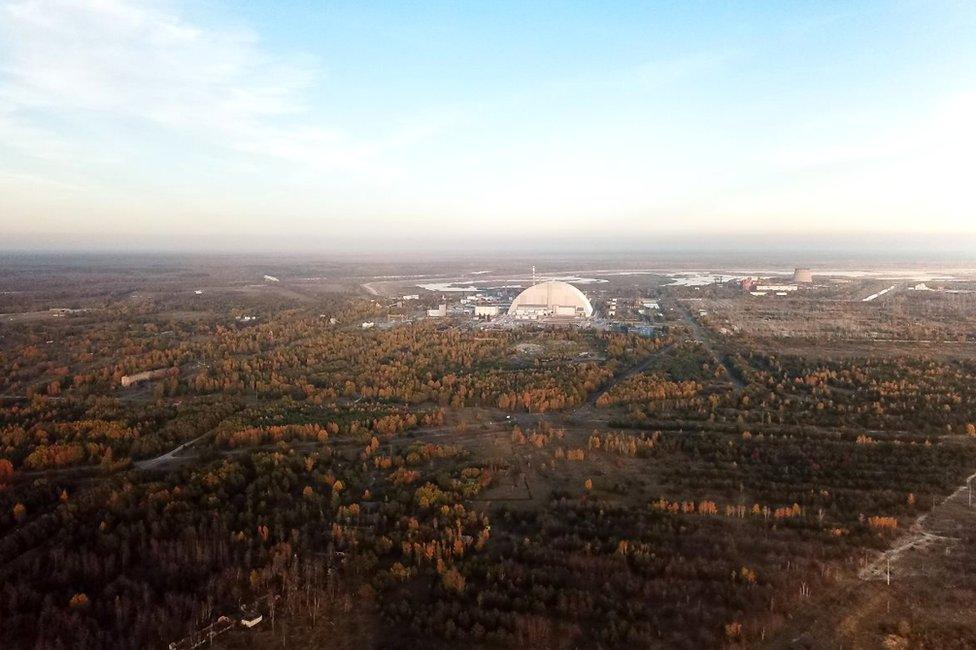
Many suspect that the radiation has or will cause other cancers, but the evidence is patchy.
Prof Richard Wakeford, from the University of Manchester's Centre for Occupational and Environmental Health, points out that health studies look for a "signal" of a specific health effect linked to Chernobyl.
They aim to pick out that signal above the "background noise" from other causes. That has been incredibly difficult, primarily because of the huge background noise that was the almost simultaneous upheaval of the Soviet Union's collapse.
"It's assumed that there will be some cancers linked to the accident in addition to the thyroid cancers, but detecting them amid that socioeconomic chaos - that had its own impacts on people's health - has proven almost impossible," says Prof Wakeford. Cancer also affects between a third and a half of people in Europe, so any Chernobyl signal is likely to be small.
Amid reports of other health problems - including birth defects - it still is not clear if any can be attributed to radiation.
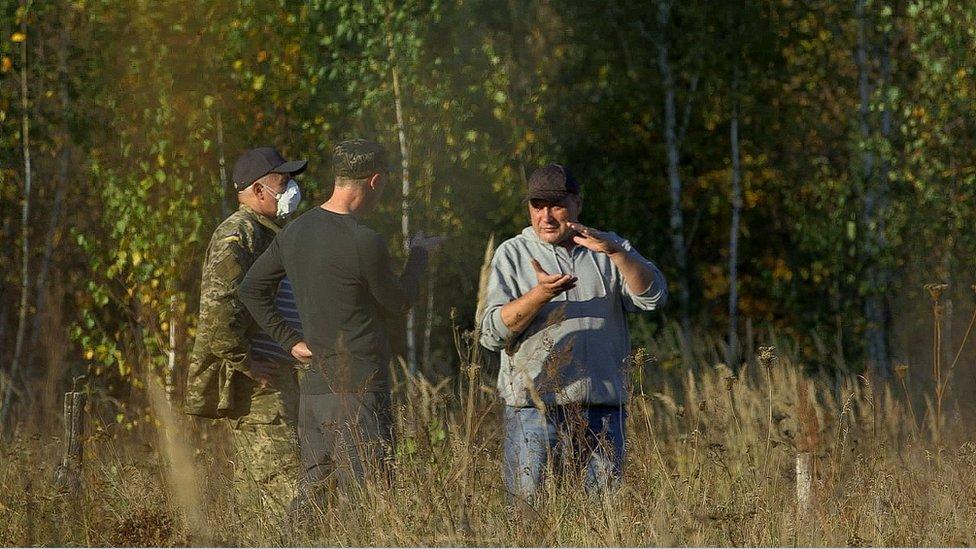
Gennady (right) and his colleagues have grown crops in the exclusion zone as part of their research
Prof Geraldine Thomas from Imperial College London explains: "Another confounding factor in this part of the world relates, confusingly, to iodine deficiency."
In its non-radioactive form, iodine is found in milk, green leafy vegetables and seaweed. A lack of it in the diet is a known cause of problems in the early development of the brain and spinal cord. "So one possible cause of birth defects is actually a lack of iodine in the environment," the prof says.
All of this means that estimates of cancer cases remain highly contentious.
In its seminal 2006 report on the the long-term consequences of the accident, the World Health Organization did conclude that many people's mental health has been damaged - by fear of radiation and severe disruption to their lives.
As a scientist who has spent years scrutinising the truth about the contamination in the zone, Gennady admits that he did not expect the people of Narodichi to be afraid of radiation.
"It's a very big factor affecting their lives, even more than 30 years after the accident. This is really something that surprised me," he says.
That fear can be physically as well as mentally damaging.
A sense of fatalism and hopelessness associated with assumptions of being doomed by radiation is thought to contribute to higher rates of of smoking and alcoholism in this region - both of which are definitively bad for people's health.
"It was a terrible thing that happened here," says Jim. "But that tends to dominate people's lives.
"Somehow - and it's very, very difficult - we've got to move towards a situation where people can go back to living their lives without this fear, this radiation blight."
We're not going anywhere
Gennady emerges from the meeting looking a little jaded, but he says he is cautiously optimistic. The map was not officially redrawn today, but, crucially, most people in the room agreed there was a need for change.
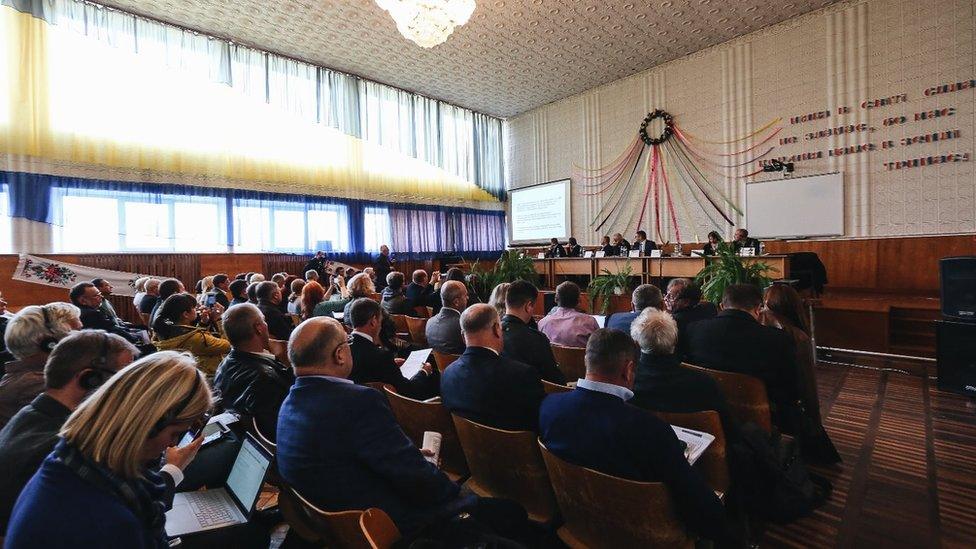
The Narodichi meeting could be a first step in transforming the district
"The community wants to bring more life here," Gennady says. "And we, as scientists, know that a lot of places here can be easily excluded from this ban, so I think this was a very positive moment."
At the kindergarten, Tatiana has ushered the younger children inside for an afternoon nap.
There are rows of adorably tiny beds inside a new wing of the kindergarten that was built with money from a Japanese charity.
The close relationship between Japan and Ukraine has been forged by the former being in the early stages of understanding the impact of its own nuclear disaster - at the Fukushima power plant.
Looking from the pristine new kindergarten building to the neighbouring derelict block, she says she would support the town's removal from the zone.
"These houses could be reconstructed and filled with people. We dream about that.
"We live here. We are not going to leave for anywhere else. Our children live here."
By BBC Science Correspondent Victoria Gill, external. Photographs by Jemma Cox. Graphics by Lilly Huynh and Sana Jasemi.